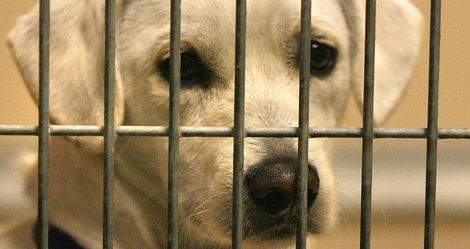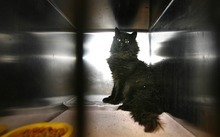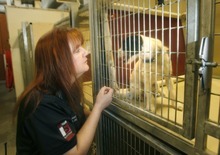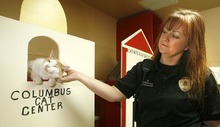This is an archived article that was published on sltrib.com in 2012, and information in the article may be outdated. It is provided only for personal research purposes and may not be reprinted.
Debbie Pedersen says cats, dogs and other animals that are euthanized should be free of fear during those last minutes of life. To that end, the South Salt Lake Animal Services supervisor supports using both gassing and lethal injection.
"Used properly, [gassing] is a benefit to us [shelter workers] because we don't have to manhandle feral cats that aren't used to being touched," Pedersen said of the gas chamber.
But animals are never gassed at Salt Lake County Animal Services.
The shelter has never had a gas chamber and injection is the only method used, according to associate director April Harris. Vicious animals can be tranquilized first, sometimes with a syringe attached to a 6-foot-long pole, to protect workers, she said.
Debate over using gas to euthanize shelter animals flared after a cat named Andrea survived two gassing attempts last fall by workers at the West Valley-Taylorsville Animal Shelter. Some animal advocates have been lobbying for a ban on the carbon monoxide chamber in West Valley City, arguing that it is humane to use an injection of sodium pentobarbital instead.
Euthanasia practices at shelters in Salt Lake County are split, according to documents released to The Salt Lake Tribune in response to requests made under the Utah Government Records Access and Management Act [GRAMA].
It is more common for shelters to use both techniques, which is the policy at the Draper, Sandy, South Jordan and West Valley City-Taylorsville shelters. Sandy also provides shelter space for Cottonwood Heights, which also uses either option.
South Salt Lake used both tactics until its gas chamber developed a leak about a year ago and couldn't be repaired.
But West Jordan and Salt Lake County euthanize by injection only. West Jordan also provides services for Murray, and Salt Lake County serves unincorporated county areas, Salt Lake City, Herriman, Holladay and Midvale.
Most of the animals euthanized by Riverton are taken to local veterinarians to be injected, while a few are put down at the South Jordan shelter.
Dennis Wilson, animal services supervisor in Draper, said a love of animals got him and other shelter employees into the job. He believes both injection and gassing are humane.
Wilson said shelters got a negative image years ago when officers were called dogcatchers and animals were euthanized after five days. Now, better training in euthanasia procedures and a push by shelters to find homes for all adoptable animals have turned things around, he said.
Animals at the Draper shelter that are eligible for adoption stay until they are placed with an owner or a rescue group, including one dog that was at the shelter for 11 months, Wilson said. Only sick or vicious animals that cannot be adopted are euthanized.
Julie Jacobs, a West Valley resident who founded United for Animals, argues gas chambers should be used only in rare cases, such as when an animal is rabid or extremely vicious. She contends that it can take up to 30 minutes for an animal to die in a carbon monoxide chamber.
"I think it's absolutely inhumane," Jacobs said.
West Valley City officials dispute that, and say chambers can be better for animals that are dangerous or difficult to inject. They also point out that the American Veterinarian Medical Association considers gassing acceptable.
Studies show that blood recognizes carbon monoxide as oxygen and animals will breathe normally until they fall asleep, according to Pedersen, who is also a veterinary technician. Death occurs after that, when the carbon monoxide reaches the brain, she said.
Carbon monoxide can be more humane for feral cats, which don't like being touched by people and have to be put in a "squeeze net" to be injected, Pedersen said. A domesticated animal might prefer touch as it is being euthanized, she said, and shelter workers do whatever they can to make animals comfortable.
"Euthanasia's not an easy thing," Pedersen said. "What it comes down to is what's the best thing for the animal. If the ability to use the gas chamber is taken away, more animals will suffer."
She added: "We're hired for public safety but we're here for animal welfare, as well."
Sharon Dennison, Sandy Animal Services director, said her shelter has not gotten objections to its gas chamber. She said the number of animals put down would decrease if owners would vaccinate, microchip and spay and neuter their pets.
Last month in West Valley City, individuals and organizations, including Best Friends Animal Society and Community Animal Welfare Society [CAWS], joined with shelter officials to promote responsible animal ownership and increase adoptions.
One participant is Janita Coombs, a CAWS volunteer who fostered Andrea after the cat survived the gas chamber. Noting the disagreements on the issue, Coombs said she is among the animal advocates who have decided to step back and let the experts continue the discussion on whether the gas chamber is appropriate.
"We want to concentrate on reducing the need for euthanasia," she said.
Twitter: @PamelaMansonSLC —
By the numbers
Records from cities in Salt Lake County list the numbers of animals impounded and the methods of euthanasia used. Officials say most or all of the animals put down in their shelters were sick, injured, not eligible for adoption because they were feral or vicious, or euthanized at the owner's request. The figures are from 2011 unless otherwise indicated.
Bluffdale • 151 impounded from July 2011 through December 2011; 95 euthanized, percentages for each method not available. Animal control services are provided by South Jordan.
Cottonwood Heights • 411 impounded, 50 euthanized, 95 percent by gas and 5 percent by injection. The city has its own animal control officers and contracts with Sandy for shelter space.
Draper • 1,035 impounded; 100 or fewer euthanized by gas or injection, percentages not available.
Murray • 870 impounded; 213 euthanized, 100 percent by injection. Animal control services are provided by West Jordan.
Riverton • 388 impounded; 102 euthanized, most by injection.
Salt Lake County • 10,293 impounded; 2,110 euthanized, 100 percent by injection. The shelter serves unincorporated county areas, Salt Lake City, Herriman, Holladay and Midvale.
Sandy • 2,727 impounded; 786 euthanized, 90 percent by gas and 10 percent by injection.
South Jordan • 712 impounded; 406 euthanized, 90 percent by gas and 10 percent by injection.
South Salt Lake • 375 impounded from January 2011 to Feb. 6, 2012; 15 euthanized, 100 percent by injection.
West Jordan • 1,925 impounded; 739 euthanized, 100 percent by injection.
West Valley City • About 5,000 impounded; 1,549 cats and dogs euthanized, 51 percent by gas and 49 by injection.













